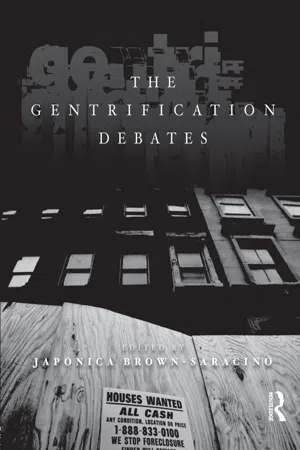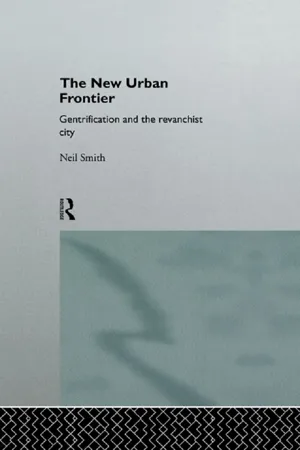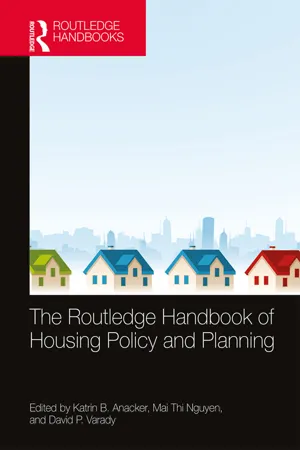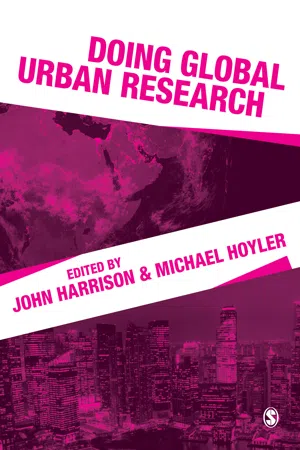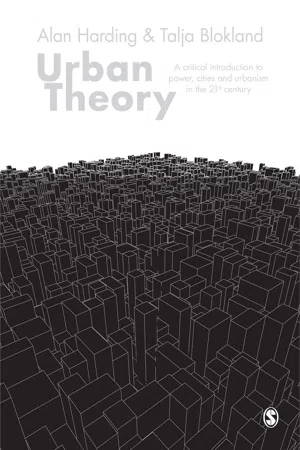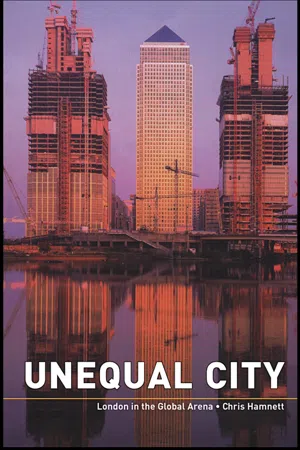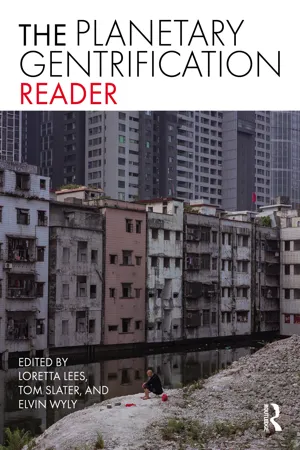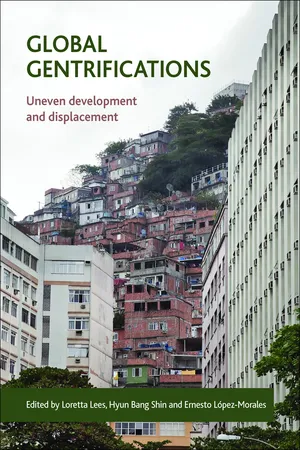Geography
Gentrification
Gentrification refers to the process of urban renewal where wealthier individuals or businesses move into a deteriorating neighborhood, often displacing lower-income residents and altering the area's character. This can lead to rising property values, improved infrastructure, and economic growth, but also raises concerns about social inequality and the loss of community identity.
Written by Perlego with AI-assistance
Related key terms
Related key terms
1 of 4
Related key terms
1 of 3
12 Key excerpts on "Gentrification"
- eBook - ePub
Globalizing Cities
A Brief Introduction
- Mark Abrahamson(Author)
- 2019(Publication Date)
- Routledge(Publisher)
Chapter 7Gentrification
Gentrification is usually defined as the process by which higher status residents replace lower status residents in a neighborhood, or other geographical area (such as a street, series of streets, census tract, etc.). To be more specific, analysts have viewed Gentrification as a change in the social class composition of a place over time, compared to other places in the same area.1 Central city neighborhoods have been a major site for such changes, but the same types of transitions have also become increasingly common in the inner suburbs of many cities as well.The conventional definition of Gentrification, presented above, emphasizes changes in the characteristics of residents, but it can also refer to changes in the retail composition of a geographical area in which art galleries, gourmet food shops, and clothing boutiques replace locally owned bakeries, barber shops, grocers, etc. The reinvestment of capital into the retail sector of a neighborhood typically follows residential Gentrification, but the temporal relationship between them can be reversed.While as we will note there is some disagreement about the consequences of Gentrification, there is little debate about its growing prevalence, especially in major (i.e., global) city-regions. Theoretically, Sharon Zukin has proposed two major explanations for why Gentrification occurs, and why it is increasing.2 The first, consumption-side, notes the growing appeal of city versus suburban living to young professionals and executives and the advantages of living closer to work in downtown areas. Such lifestyle attractions are the basis of consumption-side explanations for Gentrification, and why it frequently targets inner-city neighborhoods. The second explanation stresses how depressed land values invite investment. It is the spread between actual and potential land values that are the basis of production-side explanations, and they also focus upon deteriorated inner city neighborhoods that were formerly manufacturing centers as Gentrification targets. (Production-side is also frequently referred to as the rent gap theory, initially associated with Neil Smith.3 - eBook - ePub
The Gentrification Debates
A Reader
- Japonica Brown-Saracino(Author)
- 2013(Publication Date)
- Routledge(Publisher)
an economic and social process whereby private capital (real estate firms, developers) and individual homeowners and renters reinvest in fiscally neglected neighborhoods through housing rehabilitation, loft conversions, and the construction of new housing stock. Unlike urban renewal, Gentrification is a gradual process, occurring one building or block at a time, slowly reconfiguring the neighborhood landscape of consumption and residence by displacing poor and working-class residents unable to afford to live in ‘revitalized’ neighborhoods with rising rents, property taxes, and new businesses catering to an upscale clientele.(2004: 139)This definition captures many of the characteristics that scholars agree define Gentrification: an influx of capital and resultant social, economic, cultural, and physical transformation and displacement (see Atkinson 2003 ).If there is general agreement among scholars about these defining traits, what is there left to debate about? To varying degrees the authors in this section provide definitions and descriptions of Gentrification that overlap with Perez’s. However, each author emphasizes distinct elements of Perez’s definition. For instance, some stress the displacement of poor and working-class residents, while others devote greater attention to the transformation of housing stock. Underlying debate about how to define Gentrification are a few pressing questions. As this section details, first and foremost is the question of whether to define Gentrification by its causes, outcomes, or everyday character. A second related question is about which of Gentrification’s causes, outcomes, or dimensions typify the process. A third question involves where Gentrification takes place. In the process of posing and answering these questions scholars argue about which cases of revitalization should be deemed “Gentrification,” while simultaneously pushing each other to construct definitions that acknowledge Gentrification’s variability—i.e. the fact that its precise characteristics and dynamics vary, to an extent, by time, place, and stage of Gentrification (Clay 1979 , Kerstein 1990 - eBook - ePub
The New Urban Frontier
Gentrification and the Revanchist City
- Neil Smith(Author)
- 2005(Publication Date)
- Routledge(Publisher)
1967 edn.: III, Ch. 13)Gentrification is intimately intertwined with these larger processes. By way of the simplest explanation, let us begin with falling rates of profit. When rates of profit in the major industrial sectors begin to fall, financial capital seeks an alternative arena for investment, an arena where the profit rate remains comparatively high and where the risk is low. At precisely this point, there tends to be an increase in the capital flowing into the built environment. The result is the familiar property boom, such as affected a number of cities throughout the advanced capitalist world from 1969 to 1973 and in the late 1980s. But the question of where this capital flooding into the built environment will locate has no automatic answer. It depends in part on the geographic patterns created in the foregoing economic boom. In the case of the present restructuring of urban space, the geographical pattern confronting capital was created through the simultaneous development of the suburbs and inner-city underdevelopment. The underdevelopment of the previously developed inner city, brought about by systematic disinvestment, provoked a rent gap which, in turn, laid the foundation for a locational switch by significant quantities of capital invested in the built environment. Gentrification in the residential sphere is therefore simultaneous with a sectoral switch in capital investments.This locational switch is rarely smooth, as is illustrated by the dramatic fluctuations in new housing construction that have accompanied the booms and busts of most national economies since the 1970s. Uneven development at the urban scale therefore brought not only Gentrification in the narrowest sense but the whole gamut of restructurings: condominium conversions, office construction, recreational and service expansion, massive redevelopment projects to build hotels, plazas, restaurants, marinas, tourist arcades, and so on. All involve a movement of capital not simply into the built environment in general, in response very much to the approaching or already present economic crisis, but into the central and inner urban built environment in particular. The reason for this particular geographical focus of reinvestment can be found in the historical patterns of investment and disinvestment that represented the inner city as an opportunity for reinvestment. (In this light, incidentally, it makes sense to reassess the traditional liberal view that the 1950s state-subsidized urban renewal schemes in the US were a failure. Regardless of how socially destructive urban renewal was—and it was socially destructive—it was actually very successful economically in laying the foundation for the phase of redevelopment, rehabilitation, land use conversion and, ultimately, private-market Gentrification that would follow (Sanders 1980 - Katrin B. Anacker, Mai Thi Nguyen, David P. Varady, Katrin B. Anacker, Mai Thi Nguyen, David P. Varady(Authors)
- 2019(Publication Date)
- Routledge(Publisher)
Section 7Gentrification
Passage contains an image
21 A Moving Target
The Shifting Genealogy of Gentrification
Dennis E. GaleIntroduction
Over the past 40 years Gentrification has become an increasingly critical issue in U.S. housing policy and planning. In the late 1970s and early 1980s, Congressional hearings and federally funded studies indicated growing national concerns (U.S. Congress 1978; U.S. Congress 1986; U.S. Department of Housing and Urban Development 1980). Similar signs of Gentrification were being observed in certain cities in Canada, the UK and Western Europe, Australia, and New Zealand. Moreover, this issue has generated tremendous interest, media reportage, and scholarship. For example, a recent Google search of the term “Gentrification” received 3,730,000 hits. A search of the term in the Stanford University Library catalog turned up 322 references, including monographs and digital sources.Coined by sociologist Ruth Glass (1964), the noun “Gentrification” referred to the renovation of older London neighborhoods by middle-class households, or the new gentry, who gradually replaced their working-class predecessors. The term took root in North American lexicons in the late 1970s. Today it bears physical, demographic, economic, social, and political implications (Lees et al. 2008). Previously, U.S. scholars and other observers had referred to Gentrification as neighborhood resettlement, revitalization, regeneration, refurbishment, resurrection, and reclamation, among other terms (Laska and Spain 1980; Lees et al. 2008).1In the following sections I first discuss the counterintuitive nature of Gentrification, escalating as it did during the height of the nation’s urban crisis. Second, I address the misunderstood origins of Gentrification in the U.S. and the initial failure of federal urban renewal policies to exploit its potential. Third, I explore the elusive definitional challenges of Gentrification and the difficulties this poses for empirical research. Fourth, I briefly examine the geographic range of Gentrification with examples of scholarship in other nations. Fifth, I analyze two particularly bedeviling issues: the consumption versus production debate and the role of state sponsorship. Sixth, I discuss the issues of succession versus displacement and the differential outcomes of Gentrification. And last, I probe the variable incidence of Gentrification among U.S. cities and the implications it poses for housing affordability.- eBook - ePub
- John Harrison, Michael Hoyler, John Harrison, Michael Hoyler(Authors)
- 2018(Publication Date)
- SAGE Publications Ltd(Publisher)
Finally, Gentrification researchers need to zoom out of neighbourhoods and be inclusive of wider processes of uneven development. As much as the global circuits of capital produce uneven development across the world, the ways in which surplus capital flows into cities and regions within a national territory and into different districts and neighbourhoods within a city are inevitably uneven. Therefore, it is highly possible that the prominence of Gentrification in a city may come at the expense of urban decline elsewhere within and/or outside the city. For instance, in the UK, what does London’s super-Gentrification mean for the rest of the country? What does the domination of new-build Gentrification in Seoul mean for other regional cities in South Korea? How does the inner-city Gentrification of Beijing resulting from redevelopment projects reconcile with the concurrent processes of area-based conservation of the city’s heritage sites and the suburbanization of new estate construction? What is the implication of ‘splintering urbanism’ for Gentrification of cities in India? What does the construction of new ‘urban utopias’ (such as smart cities, eco-cities) for the middle- and upper classes in urban peripheries, a practice that is high on many government agendas in the Global South, mean for the future of historic urban cores? Reflecting diverse urban development trajectories in and outside cities around the world, there are endless questions that can be raised to help understand what kind of relationship Gentrification of a given urban space establishes vis-à-vis other spatial processes at work. Here, a helpful reminder comes from Doreen Massey (1999: 281) who in her discussion of the space of politics points out that: ‘[a]n understanding of spatiality [. . .] entails the recognition that there is more than one story going on in the world and that these stories have, at least, a relative autonomy’. In addition to this perspective, Massey (1984) also highlights the persistent challenge every geographer faces; that is, the need to analyse the uniqueness of a place without losing sight of the general cause. For Gentrification researchers and other urban scholars, it is essential to acknowledge the presence of multiple processes working simultaneously in a given space, and to discuss how these multiple processes – one of which may be Gentrification – intersect, and what kind of compounding relationship they produce.Rethinking Gentrification as amalgamation of economic, political and ideological projects: An illustrated case study of BeijingGentrification as an economic project is a well-known argument (see Lees et al., 2008). The transformation of the demographic structure of a gentrified neighbourhood accompanied by upgrading or redevelopment of dilapidated dwellings is a welcoming change from the perspective of local government officials who equate the change with higher tax revenues, and of developers, financiers and property agents who welcome the new business opportunities (Betancur, 2002; Lang, 1986). In a place where land revenues are collected directly by local governments to be put into public finance for further development of infrastructure, Gentrification is more than the beautification of the cityscape. This is the case in mainland China where under state ownership of urban construction land, land use rights are transferred from the state to developers in return for land use premium and other administrative charges (Hsing, 2010; Lin, 2015). Revenues collected in this way are known to account for a substantial share of municipal finance, sometimes exceeding the amount of other tax revenues (known as budgetary income as opposed to extra-budgetary income that land accounts belong to) (Hsing, 2010; Lin, 2015). - eBook - ePub
- Loretta Lees, Tom Slater, Elvin Wyly(Authors)
- 2013(Publication Date)
- Routledge(Publisher)
How, in the large context of changing social geographies, are we to distinguish adequately between the rehabilitation of nineteenth-century housing, the construction of new condominium towers, the opening of festival markets to attract local and not so local tourists, the proliferation of wine bars—and boutiques for everything—and the construction of modern and postmodern office buildings employing thousands of professionals, all looking for a place to live?... Gentrification is no longer about a narrow and quixotic oddity in the housing market but has become the leading residential edge of a much larger endeavour: the class remake of the central urban landscape.(N. Smith 1996a: 39)New-build residential developments, nevertheless, stand in stark contrast to the renovated Victorian and Georgian landscapes of classic Gentrification texts (e.g., those of Glass [1964] and N. Smith [1982]). Th is has led housing researchers such as Christine Lambert and Martin Boddy (2002: 20) to question whether new-build, city center residential landscapes can in fact be characterized as Gentrification at all:[W]e would question whether the sort of new housing development and conversion described in Bristol and other second tier cities, or indeed the development of London’s Docklands, can, in fact, still be characterised as “Gentrification”—post-recession or otherwise. There are parallels: new geographies of neighbourhood change, new middle class fractions colonising new areas of central urban space, and attachment to a distinctive lifestyle and urban aesthetic. But “Gentrification”, as originally coined, referred primarily to a rather different type of “new middle class”, buying up older, often “historic” individual housing units and renovating and restoring them for their own use—and in the process driving up property values and driving out former, typically lower income working class residents. Discourses of Gentrification and the Gentrification literature itself do represent a useful starting point for the analysis of the sort of phenomenon discussed above. We would conclude, however, that to describe these processes as Gentrification is stretching the term and what it set out to describe too far.Debating these positions, Davidson and Lees (2005) drew up the cases for and against new-build Gentrification (see Box 4.1 ). - eBook - ePub
Urban Theory
A critical introduction to power, cities and urbanism in the 21st century
- Alan Harding, Talja Blokland(Authors)
- 2014(Publication Date)
- SAGE Publications Ltd(Publisher)
Gentrification as a process was modelled influentially and early in the debate by Clay (1979) who distinguished four steps. First the pioneers come – artists, bohemians, people willing to take risks and in search of cheap housing. They are then followed by developers and investors. When the media pick up that an area is becoming ‘hip’, more established middle classes take an interest in the place and prices rise. Finally, these middle-class professionals are outpriced by managers and business elites. While this notion of stages has gained textbook status, it is now widely felt that this model was too rigid, insufficiently context-dependent and sincerely limits Gentrification as usable as a concept only if artists and bohemians move into an area first – as if no Gentrification is possible without artists which is, as many smaller Dutch and German cities can testify, definitely not the case. Berry (1985) tried to develop a more inclusive model including the stages in which the role of the various actors involved, not just the gentrifiers themselves, was made clearer and demand and supply sides combined. Bourne’s (1993) approach was similar, but his modelling was more a matter of defining conditions for Gentrification rather than the stages that the process would follow, and, especially, a plea to see Gentrification as one of many of the processes that change cities. Two decades later, many may argue that Bourne was ‘wrong’ to expect Gentrification to become less important when the pool of gentrifiers simply shrank, and more cities may have witnessed some variation of Gentrification – whether or not this is the case of course depends on how one defines the process in the first place! – but that does not make the remark with which he concluded his contribution less important: ‘the challenge for the future will not be the emergence of the elite inner city, but the instability, vulnerability, and in some instances rapid decline of a host of other neighbourhoods’ (Bourne, 1993: 105). Within our metaphor of spikiness, the valleys are valleys because there are peaks, and Gentrification can be seen as a spatial expression of more severe inequalities, making the urban landscape spikier. To understand processes of marginalisation, however, requires also the study of Gentrification, as both relationally produce sites that structure resource opportunities for their users.Production versus consumption
Since the 1980s, two perspectives have dominated explanations of Gentrification: perspectives that focus on production and those that focus on consumption. The most famous author to explain Gentrification through the lens of the mode of production was Neil Smith, a geographer and student of David Harvey, who initially wrote against the 1960s and 1970s explanations that, similar to those we have seen for suburbanisation, assumed consumer sovereignty, and heavily influenced subsequent debate (Smith, 1983). Smith argued that understanding investments and land values was essential to understanding Gentrification as a capitalist process. Land and buildings are commodities under capitalism, he argued, and Gentrification occurs within the context of the value of land and buildings. The ground rent, that is, the return on the investment given the current land use, may not be optimal, the amount that could be generated by the best use (Smith, 2010: 90) so that a rent gap may exist: the disparity between the potential ground rent level and the actual ground rent capitalised under the present land use (Smith, 2010: 93). He summarises the Gentrification process as follows:Only when this gap emerges can redevelopment be expected since if the present use succeeded in capitalizing all or most of the ground rent, little economic benefit could be derived from redevelopment. As filtering and neighborhood decline proceed, the rent gap widens. Gentrification occurs when the gap is wide enough that developers can purchase shells cheaply, can pay the builders’ costs and profit for rehabilitation, can pay interest on mortgage and construction loans, and can then sell the end product for a sale price that leaves a satisfactory return to the developer. The entire ground rent … is now capitalized; the neighborhood has been ‘recycled’ and begins a new cycle of use. (Smith, 2010: 93) - eBook - ePub
- Leslie Kern(Author)
- 2022(Publication Date)
- Between the Lines(Publisher)
6 . Gentrification Is About Physical DisplacementRuth Glass was certainly prescient when she predicted the complete social transformation of neighbourhoods in her 1964 definition of Gentrification. Displacement, she suggested, was at the heart of Gentrification. Since then, displacement has remained central, yet confounding, as there are many different definitions, causes, and ways of measuring displacement. What does displacement really look and feel like? What are the everyday experiences that lead to a lost sense of place or belonging? For qualitative researchers like me, people’s personal accounts are compelling data. For quantitative analysts, measuring changes in household type and income, housing tenure, and rates of eviction based on census, planning, and other survey data is usually preferred. Whatever approach you take, any study of Gentrification must confront displacement in all its forms and reckon with the deep and lasting impacts on people’s lives.The standard story of Gentrification has tended to focus on one form of displacement: the out-migration of working-class and/or racialized residents from gentrifying areas. A picture gets painted of a neighbourhood undergoing a total turnover in the class and identity of inhabitants, businesses, and services over a period of time. This story implies that few, if any, “original” residents remain. Here, Gentrification has a distinct before and after. This story compels us to look for quantitative evidence of the physical departure of certain people from the community. Without proof of this particular trajectory and kind of displacement, some observers do not believe Gentrification has occurred at all.Unfortunately for those who like to have neat graphs and uncomplicated narratives, Gentrification is often messy, drawn out, and without a clear endpoint. The desire to tell a straightforward story means researchers and writers might be pulled toward studying places where displacement has “happened” in some kind of eventful way, rather than considering the ordinary neighbourhoods where displacement and Gentrification are affecting people slowly, emotionally, and often quietly. Sometimes we have to eschew clean notions of a measurable before and after in order to understand displacement as a multi-layered, multitemporal, and relational process that defies simple packaging. - eBook - ePub
Unequal City
London in the Global Arena
- Chris Hamnett(Author)
- 2004(Publication Date)
- Routledge(Publisher)
London: Aspects of Change, published in 1963, that:(Glass, 1963, p. xviii)One by one, many of the working class quarters of London have been invaded by the middle classes—upper and lower—shabby modest mews and cottages—two rooms up and two down—have been taken over when their leases expired, and have become elegant, expensive residences. Larger Victorian houses, downgraded in an earlier or recent period–which were used as lodging houses or were otherwise in multiple occupation—have been upgraded once again… Once this process of ‘Gentrification’ starts in a district it goes on rapidly until all or most of the original working class occupiers are displaced and the whole social character of the district is changed.Her use of the term ‘Gentrification’, which sometimes vexes American academics who would prefer the term neighbourhood ‘revitalisation’ or ‘renovation’ was deliberately ironic and rooted in the intricacies of traditional English rural class structures. It was designed to point to the emergence of a new ‘urban gentry’, paralleling the eighteenth-and nineteenth-century rural gentry familiar to readers of Jane Austen, who comprised the class strata below the landed aristocracy, but above yeoman farmers and landless labourers. She identified Gentrification as a complex process involving physical improvement of the housing stock, housing tenure changes from renting to owning, price rises and the displacement or replacement of the working-class population by the new middle class. She was not alone in recognising the emergence of Gentrification in London. Several key elements of the process were brilliantly captured by Michael Frayn (1967) in his novel, Towards the End of the Morning: - eBook - ePub
- Loretta Lees, Tom Slater, Elvin Wyly, Loretta Lees, Tom Slater, Elvin Wyly(Authors)
- 2022(Publication Date)
- Routledge(Publisher)
Butler and Lees, 2006 ) involving people with very high levels of economic capital.Concepts such as economic and cultural capital facilitate universalizing comparisons through simplifying or ‘abbreviating’ (Robinson, 2015 ) the complexity of everyday life by focusing on particular, repeated aspects. Given this, it is unsurprising that studies of the UK countryside have made comparisons between stages and assets identified in urban studies and processes of change observed in rural areas (Phillips, 2005 ; Smith, 2002a ). It appears that many UK rural localities have experienced intensified and generalized Gentrification, given their high levels of middle class residence (Phillips, 2007 ). In the United States, the ‘American West’ has been a focus of attention within rural Gentrification studies (Figure 3 ), and according to Nelson and Nelson (2010) , is an area where it appears most widely present, although also occurring more sporadically across rural areas in the Mid-West, the South and the Eastern seaboard. Even in the American West, however, rural Gentrification is shown to be concentrated in a relatively small number of areas, with Hines (2012 : 75) likening its geography to an ‘archipelago’ of change set within ‘the midst of a relatively static, conservative, agricultural/industrial “sea”’. In France, the progress of rural Gentrification appears even more sporadic, as well as widely perceived via other process descriptors, such as international or neo-rural in-migration, tourism or peri-urban or new-build development. A study of the High Corbie’res has, however, suggested that neo-rural migration reflected an early sporadic phase of Gentrification which was followed by inflows of people with both more economic assets and greater levels of cultural capital (Perrenoud and Phillips, forthcoming - eBook - ePub
- Leslie Kern(Author)
- 2022(Publication Date)
- Verso(Publisher)
6 Gentrification IS ABOUT PHYSICAL DISPLACEMENTRuth Glass was certainly prescient when she predicted the complete social transformation of neighbourhoods in her 1964 definition of Gentrification. Displacement, she suggested, was at the heart of Gentrification. Since then, displacement has remained central, yet confounding, as there are many different definitions, causes, and ways of measuring displacement. What does displacement really look and feel like? What are the everyday experiences that lead to a lost sense of place or belonging? For qualitative researchers like me, people’s personal accounts are compelling data. For quantitative analysts, measuring changes in household type and income, housing tenure, and rates of eviction based on census, planning, and other survey data is usually preferred. Whatever approach you take, any study of Gentrification must confront displacement in all its forms and reckon with the deep and lasting impacts on people’s lives.The standard story of Gentrification has tended to focus on one form of displacement: the out-migration of working-class and/or racialized residents from gentrifying areas. A picture gets painted of a neighbourhood undergoing a total turnover in the class and identity of inhabitants, businesses, and services over a period of time. This story implies that few, if any, “original” residents remain. Here, Gentrification has a distinct before and after. This story compels us to look for quantitative evidence of the physical departure of certain people from the community. Without proof of this particular trajectory and kind of displacement, some observers do not believe Gentrification has occurred at all.Unfortunately for those who like to have neat graphs and uncomplicated narratives, Gentrification is often messy, drawn out, and without a clear endpoint. The desire to tell a straightforward story means researchers and writers might be pulled toward studying places where displacement has “happened” in some kind of eventful way, rather than considering the ordinary neighbourhoods where displacement and Gentrification are affecting people slowly, emotionally, and often quietly. Sometimes we have to eschew clean notions of a measurable before and after in order to understand displacement as a multi-layered, multi-temporal, and relational process that defies simple packaging. - eBook - ePub
Global Gentrifications
Uneven Development and Displacement
- Lees, Loretta, Shin, Hyun Bang(Authors)
- 2015(Publication Date)
- Policy Press(Publisher)
EIGHTWidespread and diverse forms of Gentrification in Israel
Amiram GonenIntroduction
My ongoing observations over the last three decades on patterns of Gentrification in Israeli inner cities, suburban towns and rural communities have led me to view Gentrification from a different geographical perspective to the one shared by many Western researchers writing on Gentrification. Research on Gentrification originated in the heart of some Western cities and, therefore, Gentrification was often characterised as primarily an inner-urban phenomenon. It was first observed and defined in an academic fashion in inner London (Glass, 1964) and subsequently studied in the 1980s and early 1990s in the inner city of some North American and British cities (for references to these early studies, see Lees et al, 2008). Indeed, the settling of middle class households in lower-social class neighbourhoods of the inner city has achieved sizeable proportions in Western cities since the 1970s. Much of the debate that developed among social scientists was over whether Gentrification posed a substantial challenge to the established socio-spatial structure of Western cities, postulated by the concentric model of the Chicago School (Burgess, 1925). According to this model, based solely on industrialised cities in the US, the lower classes tended to live in the inner city while the middle classes opted for outer-urban and suburban neighbourhoods. The main theoretical question raised in early Gentrification debates was whether the renewed interest of the middle classes in the inner city would bring about a reshuffling of the socio-spatial structure of the North American city (eg Smith, 1986). The debate was also centred on identifying the major driving force behind inner-city Gentrification: was it economically generated by a rent gap existing in the inner city or was it the result of a growing cultural shift from a suburban to an urban lifestyle? All of this debate was primarily based on the concentric model of socio-spatial structure specific to US cities.
Index pages curate the most relevant extracts from our library of academic textbooks. They’ve been created using an in-house natural language model (NLM), each adding context and meaning to key research topics.
Explore more topic indexes
Explore more topic indexes
1 of 6
Explore more topic indexes
1 of 4

